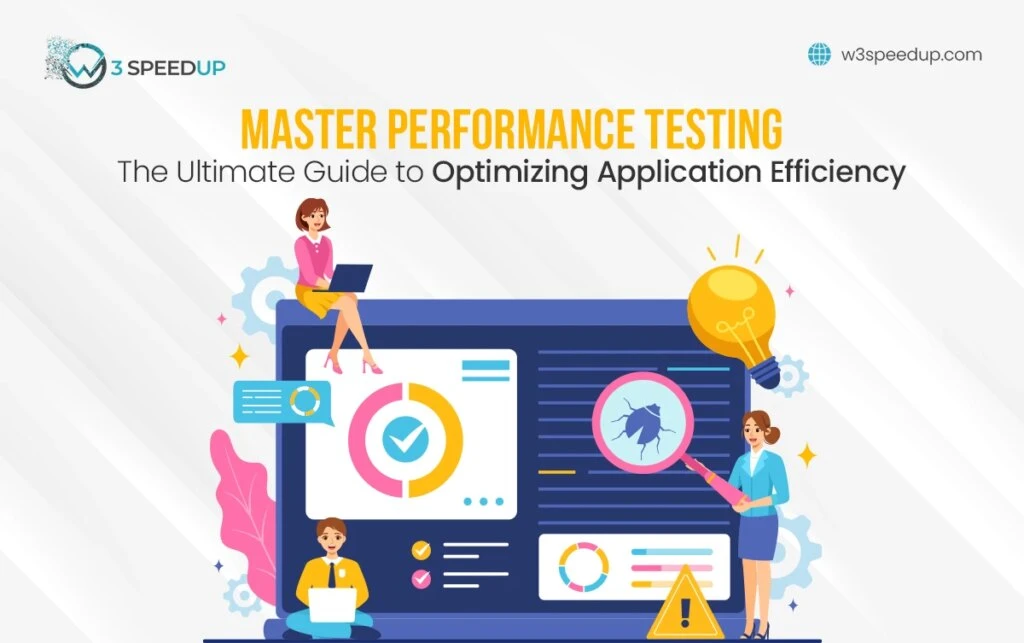Performance testing is critical to implement in the software testing phase. It ensures that apps not only fulfill the functional needs of the project but also deliver strong performance under different conditions.
For novice testers of this dynamic realm of software testing, knowing the importance of performance testing is paramount. An expert software testing company never fails to implement performance testing in their projects.
In this comprehensive guide, we aim to help you understand what performance testing is, its significance, key tools, and much more. Let’s begin!
What is Performance Testing?
Performance testing understands the system’s performance based on stability and responsiveness under a specific workload. It isn’t just about reliability, but also speed, resource usage, and scalability. Here are the primary objectives of performance testing:
- Stability- Ensures whether the app/software remains stable even in constantly changing usage loads
- Scalability- checks whether the system maintains efficiency when the demand enhances
- Speed- Verifies the speed of the system’s response
What Are the Different Types of Performance Testing?
Let us now understand different types of performance testing; and how they help testers test applications’ performance from different aspects.
 Stress Testing
Stress Testing
Stress testing needs evaluation further by just subjecting the system to extreme load situations. Here the system is pushed beyond normal limits to check its breaking point, and how gracefully it recovers.
 Load Testing
Load Testing
Load testing includes increasing expected loads and then evaluating whether the app is capable of responding under particular situations. It will help you identify the maximum load capacity of the system while not interrupting its performance.
 Endurance Testing
Endurance Testing
This type of testing is also called soak testing, as it evaluates the system’s performance over an extended period in normal or maximum stress conditions. It identifies resource issues, memory leaks, and more.
 Volume Testing
Volume Testing
Here, testers can assess the complete ability of the system to manage voluminous data like transactions, database entries, etc. It ensures that the app/software remains uninterrupted even as the data volume increases.
 Spike Testing
Spike Testing
Spike testing includes simulating quick bursts of spikes in the user traffic and assessing how the software will handle a sudden increase in the user load. Testers can test the system’s performance during peak times through this process.
Why is Performance testing important?
- Better User Experience- PT (Performance Testing) plays an important role in improving the overall customer experience by making apps respond reliably and quickly
- Maintains reliability- It helps in maintaining the reliable performance of the app software
- Reduction in different risks- Search and solve performance issues easily in the software development cycle, and help avoid risks of poor performance.
Procedure for Performance Testing
Implementing the QA best practices of performance testing will have sequential steps to follow, here are the steps to be followed:
- Search testing environment- Find the accurate environment in which the system can be tested well. It can be a platform or tool that should match the hardware and software compatibility, along with network configurations, and more
- Look for the performance acceptance norm- Set one parameter that the software must achieve to pass the performance tests. It means that testers should establish a benchmark that should be achieved while implementing performance testing.
- Design suitable performance tests- try making and identifying different test scenarios that help in implementing the test cases.
- Configure testing environment- Make test environments by gathering necessary data about requirements through APIs, hardware, and software configurations to perform necessary levels of testing.
- Implement tests- The test design that you made according to the project, now, it’s the time to implement them
- Run tests- Run the test cases and check the results to refine them in the next step.
- Retest and analyze- Till the result is not as per the expectations, you can suggest developers to rectify the errors. After that, you can retest and reanalyze.
Popular Tools for Performance Testing
Here are the most popular tools for performance testing:
- Apache JMeter– one of the open-source and widely used tools
- Gatling- this tool is famous for its efficiency in developing test scenarios
- LoadRunner- It offers real-time monitoring
- NeoLoad- This tool is popular for its user-friendly interface and provides speedy test results
- AppDynamics- This popular tool goes beyond performance testing by giving app performance management tools.
- Apache Benchmark (AB)- AB is a command-line tool made for testing the performance of the app and its HTTP servers.
Performance Testing- Final Verdict
Performance testing in the software isn’t just about evaluating the system, it also ensures that a software app responds and operates accurately at varying speeds and under various scenarios.
It is necessary to address and solve potential obstacles and bugs to ensure the quality performance of the product. Ultimately, this type of testing along with QA testing is necessary to ensure that the quality of your software isn’t breached and its performance is up to the mark.


